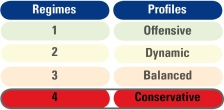NXS Dynamic Multi Factor U.S. Equity Index – Permanent suspension of the calculation and publication of the Index
Performance & Volatility
| Intraday | 1m | 3m | ytd | 1y | 3y | 5y | |
|---|---|---|---|---|---|---|---|
| Accumulated performance | -0.42% | 2.97% | 6.80% | n/a | 6.61% | 31.56% | 31.18% |
| Volatility | n/a | 9.90% | 9.23% | 10.69% | 12.93% | 12.85% | 13.83% |
| Accumulated performance | Volatility | |
|---|---|---|
| Intraday | -0.42% | n/a |
| 1m | 2.97% | 9.90% |
| 3m | 6.80% | 9.23% |
| ytd | n/a | 10.69% |
| 1y | 6.61% | 12.93% |
| 3y | 31.56% | 12.85% |
| 5y | 31.18% | 13.83% |
Last valuation date : 22/04/2019
Risk / Return from : 01/01/1999
| Annualized return | Volatility | Information ratio | Max |
|---|---|---|---|
| 9.48% | 17.42% | 0.54 | -45.54% |
| Annualized return | 9.48% |
| Volatility | 17.42% |
| Information ratio | 0.54 |
| Max Drawdown | -45.54% |
All information for an index prior to its Inception Date is back-tested, based on the methodology that was in effect on the Inception Date. Back-tested performance, which is hypothetical and not actual performance, is subject to inherent limitations because it reflects application of an Index methodology and selection of index constituents in hindsight. No theoretical approach can take into account all of the factors in the markets in general and the impact of decisions that might have been made during the actual operation of an index. Actual returns may differ from, and be lower than, back-tested returns.
The key elements of the index methodology are available upon demand.
The NXS Dynamic Multi Factor US Equity index is a dynamic strategy index exposed to a basket of equity risk factor strategies.
The aim of the index is to achieve exposure to US equity markets cycles via a basket of Natixis proprietary indices, due to an asset allocation model that determines relative weightings for each strategy.
The portfolio allocation is dynamically managed depending on the market’s risk regime.
The combined use of a market signal (Advanced Risk Perception Indicator) and a statistical filter model (Hidden Markov Model) makes it possible to adapt the investment’s risk / reward profile.
The portfolio consists of the 5 other Risk Premia Equity indices. Strategies are allocateddepending on their behavioural characteristics in a given risk regime (the Value factor, for example, tends to underperform when the market’s risk regime is high). The strategies presented within a same given risk regime are equally weighted.
So-called alternative risk premia are constructed so as to capture the return beyond traditional sources of beta coming from certain market inefficiencies, due to: investor behaviour, structural distortions on certain markets and imbalances between supply and demand.
These alternative risk premia (Value, Size, Carry, Momentum, Low Volatility) were identified: as the remuneration for a risk factor, on a sound economic justification and on the basis that the risks relating to this factor are stable.




